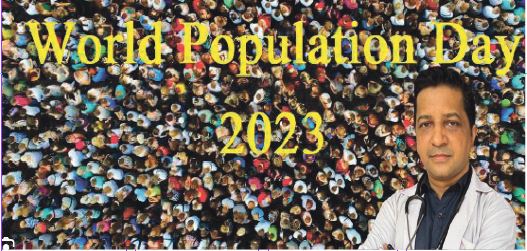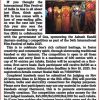Goa is abuzz with excitement as vintage bike and car owners, users, collectors and fans are decking […]

8 BILLION LIVES: INFINITE POSSIBILITIES A time to celebrate or contemplate? A message of hope on World Population Day
July 15- July 21 2023, MIND & BODY, HEART & SOUL July 14, 2023JULY 11 is World Population Day and the Goan Observer caught up with DR AMIT DIAS from the Department of Preventive & Social Medicine, GMC, to get a better understanding of the current scenario given the United Nation’s agency report showing that India has overtaken China as the most populous country in the world. “We need to understand that we have 8 billion lives and infinite possibilities,” says Dr Dias. We also get his views on the declining sex ratio in the state of Goa as reported in the NFHS 5.
Q: Why do we observe Population Day on July 11?
A: Population has a huge impact on our economy, our health, and our life. World Population Day focuses on the importance of population-related issues and is observed on July 11 as this was the day in 1987 when the world population reached 5 billion. We need to understand the implications and make provisions for a future with sustainable development.
Q: Is our population exploding? Where do we stand in India?
A: Yes, the population is rising and the impact is not only on the family, but much beyond. In 1804 the world population reached 1 billion and it took thousands of years to get there. However, in the last 220 years, the population has risen exponentially and has increased eightfold to reach the 8 billion mark. The trends have far-reaching implications for the future and we needs to be aware and make provisions for the same. In India, we have 16% of the world’s population, while we share only 2.4% of the land area.
All regions go through five phases of the demographic cycle. The first is when there is a high birth rate and high death rate — it is called the high stationary phase. The two cancel out and the population remains stable. We were in that phase several years ago. The next is the early expanding phase where the birth rate remains high and the death rate starts to fall — this is the early expanding phase. The third phase is when the birth rate and the death rate fall but the birth rate is still higher than the death rate. India is currently in this phase called the late expanding phase. This is followed by the low stationary and the declining phase. The low and middle-income countries are showing a rising trend while the developed countries have stabilized and some started to decline.
Similarly, in India as a country we are in the late expanding phase; however, certain regions such as Goa are in the more advanced phase of the demographic cycle where the population is showing a declining trend, which is also a factor we need to consider and address.
Q: On World Population Day is it time to celebrate or mourn?
A: It all depends on how we handle it, we have infinite possibilities!! If we can take advantage of the situation, we can turn the tables, I would say it’s a time to contemplate and coordinate.
According to the UNFPA report the population of the world is 8.045 billion, of which 65% are in the age group of 15-64 years which is the active age group. We need to be able to ensure that our youth are educated, skilled and employed. If they are uneducated, unskilled, and unemployable, then our demographic dividend will turn into a catastrophic burden. This is very much true for India where we have a large proportion of the young population; however, we need to ensure that all of them have the skills to move forward and also contribute to the overall progress of the nation. We need to take advantage of this demographic opportunity.
However, uncontrolled growth of the population will result in increasing poverty, hunger, homelessness, poor sanitation, sickness, destruction of the environment, unemployment, and a host of other problems!
Q:What are the factors that affect population growth?
A: Several factors affect population growth and family planning is not the only one. Education, female literacy, avoiding early marriages, employment, cultural beliefs, are some of the factors. Having a good health network and a robust program for maternal and child health is also an important factor. We were the first country to have a systematic program to address this need. Currently, the Ministry of Health & Family Welfare has the RMNCH+A program under the National Health Mission. Earlier, people would have a lot of children as a security measure, as they didn’t know how many would live to adulthood. If we ensure that the education and health of the child is taken care of by the government, people will automatically have smaller families. Goa is a state with a very good health care network, high literacy, and late age of marriage, and the result is seen in the population trend in the state of Goa. In fact, we need to be concerned because our population is on the decline.
Q: What about the sex ratio and the balance in the country? The recent NFHS-5 data showed dismal figures for the state of Goa. What do you think about it?
A: For the benefit of everyone, let me explain that sex ratio, is the ratio of females per thousand males, needs to be maintained. The NFHS-5 data stated that Goa has the lowest sex ratio for the population under 7 years of age which was 774 per 1000 males. I don’t want to dismiss this finding, but would caution that it needs reassessment. It appears skewed and there seems to be a sampling error. Goa has an excellent births and deaths registration system and the data from the Civil Registration System released in 2020, indicated that the sex ratio was 947 per 1000 males which is more likely to be the actual picture. It still means that we need to address gender discrimination even in a progressive state like Goa.
In fact, gender-based discrimination is a topic that needs to be addressed and keeping this in mind, the theme for World Population Day this year is “Gender-based discrimination harms everyone: Women, Girls, Men and Boys. Investing in women and girls to unlock our world’s infinite possibilities.”
Q: What is your message to our readers?
A: I am happy they are reading this till the end. What we do today, will shape the future. We need to celebrate diversity and promote peace, equality, education, women empowerment, and sustainable development. While we talk about women empowerment, we must also focus on the role of men in population control. Empower people with rights, choices and the wisdom to take the right decision and find answers to the questions that the rising billions throw at us.
It is good to have people living longer. But are we doing enough to ensure that we are adding life to their years? It is good to have a growing young population, but are we doing enough to equip them with the skills to be independent? It is good to be a growing economy, but are we doing enough to bridge the yawning gap between the rich and the poor? If our systems are in place they should be able to cater to the growing needs and changing demographic pattern of our population.
Let’s work towards sustainable development. It’s true that we have 8 billion lives, but we also have infinite possibilities to help them.
(Dr Amit Dias, MD, is faculty at the Goa Medical College at the Department of Preventive & Social Medicine and has been involved in training medical professionals in the medical certification of cause of death with the Department of Census and Planning and Statistics, Govt of Goa.)















